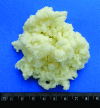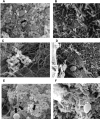Microbiological, technological and therapeutic properties of kefir: a natural probiotic beverage
- PMID: 24294220
- PMCID: PMC3833126
- DOI: 10.1590/S1517-83822013000200001
Microbiological, technological and therapeutic properties of kefir: a natural probiotic beverage
Abstract
Kefir is a fermented milk beverage produced by the action of bacteria and yeasts that exist in symbiotic association in kefir grains. The artisanal production of the kefir is based on the tradition of the peoples of Caucasus, which has spread to other parts of the world, from the late 19(th) century, and nowadays integrates its nutritional and therapeutic indications to the everyday food choices of several populations. The large number of microorganisms present in kefir and their microbial interactions, the possible bioactive compounds resulting of microbial metabolism, and the benefits associated with the use this beverage confers kefir the status of a natural probiotic, designated as the 21(th) century yoghurt. Several studies have shown that kefir and its constituents have antimicrobial, antitumor, anticarcinogenic and immunomodulatory activity and also improve lactose digestion, among others. This review includes data on the technological aspects, the main beneficial effects on human health of kefir and its microbiological composition. Generally, kefir grains contain a relatively stable and specific microbiota enclosed in a matrix of polysaccharides and proteins. Microbial interactions in kefir are complex due to the composition of kefir grains, which seems to differ among different studies, although some predominant Lactobacillus species are always present. Besides, the specific populations of individual grains seem to contribute to the particular sensory characteristics present in fermented beverages. This review also includes new electron microscopy data on the distribution of microorganisms within different Brazilian kefir grains, which showed a relative change in its distribution according to grain origin.
Keywords: fermented milk; kefir; kefir grains; microbial diversity; probiotic.
Figures


References
-
- Assadi MM, Pourahmad R, Moazami N. Use of isolated kefir starter cultures in kefir production. World J Microbiol Biotechnol. 2000;16:541–543.
-
- Beshkova D, Simova ED, Simov ZI, Frengova GI, Spasov ZN. Pure cultures for making kefir. Food Microbiol. 2002;19:537–544.
-
- Bottazzi V, Bianchi F. A Note on Scanning Electron Microscopy of Micro-organisms associated with the Kefir Granule. J Appl Microbiol. 1980;48:265–268.
-
- Carneiro RP. M.Sc. Dissertation. Belo Horizonte, Brasil: Faculdade de Farmácia. UFMG; 2010. Desenvolvimento de uma cultura iniciadora para produção de kefir; p. 142.
-
- Cheirsilp B, Shimizu H, Shioya S. Enhanced kefiran production by mixed culture of Lactobacillus kefiranofaciens and Saccharomyces cerevisiae. J Biotechnol. 2003;100:43–53. - PubMed
Publication types
MeSH terms
LinkOut - more resources
Full Text Sources
Other Literature Sources
